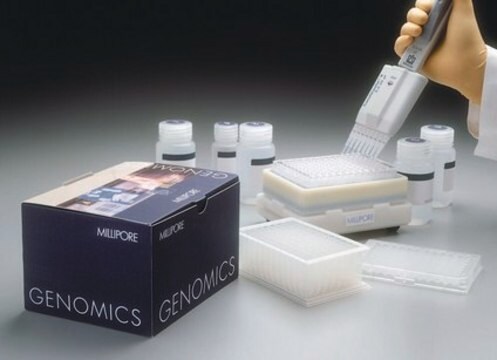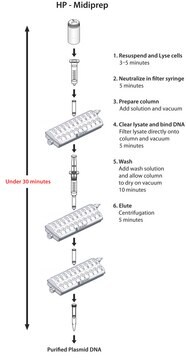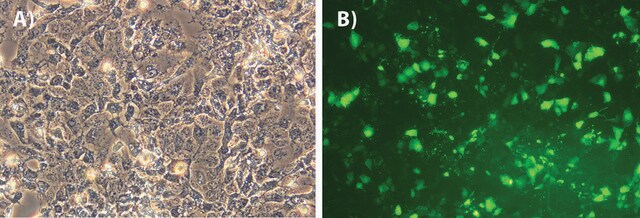PLN10
GenElute™ Plasmid Miniprep Kit
sufficient for 10 purifications
Synonym(s):
GenElute™ Plasmid Kit, Gen Elute
Sign Into View Organizational & Contract Pricing
All Photos(4)
About This Item
UNSPSC Code:
12352200
NACRES:
NA.52
Recommended Products
usage
sufficient for 10 purifications
greener alternative product characteristics
Designing Safer Chemicals
Learn more about the Principles of Green Chemistry.
Looking for similar products? Visit Product Comparison Guide
General description
The GenElute Plasmid Miniprep Kit offers a simple, rapid, and cost-effective method for isolating plasmid DNA from recombinant E. coli cultures. By combining silica-binding technology and the convenience of a spin column format, up to 15 μg of high copy plasmid DNA can be recovered from 1-5 mL of E. coli culture in less than 30 minutes. Note that actual yield and optimal volume of culture to use depend on the plasmid and the culture medium.
An overnight recombinant E. coli culture is harvested with centrifugation and subjected to a modified alkaline-SDS lysis procedure followed by adsorption of the DNA onto silica in the presence of high salts. Contaminants are then removed by a spin-wash step. Finally, the bound DNA is eluted in water or Tris-EDTA buffer.
An overnight recombinant E. coli culture is harvested with centrifugation and subjected to a modified alkaline-SDS lysis procedure followed by adsorption of the DNA onto silica in the presence of high salts. Contaminants are then removed by a spin-wash step. Finally, the bound DNA is eluted in water or Tris-EDTA buffer.
We are committed to bringing you Greener Alternative Products, which adhere to one or more of The 12 Principles of Greener Chemistry. This product has Inherently Safer Chemistry, compared to the standard use of phenol and chloroform to perform DNA extractions.
Application
The DNA is ready for immediate use in applications such as restriction enzyme digestion, cloning, PCR, transformation, transcription, conventional, and automated sequencing.
The DNA isolated with the help of this kit has been used for transfection.
Features and Benefits
- Purified plasmid DNA in less than 30 minutes
- Purify up to 15 μg of plasmid DNA
- No detectable genomic DNA or RNA contamination
- No phenol/chloroform extraction or alcohol precipitation required
Other Notes
For additional information, please see www.sigma-aldrich.com/genelutehp.
Legal Information
GenElute is a trademark of Sigma-Aldrich Co. LLC
related product
Product No.
Description
Pricing
Signal Word
Danger
Hazard Statements
Precautionary Statements
Hazard Classifications
Acute Tox. 4 Oral - Eye Irrit. 2 - Flam. Liq. 3 - Met. Corr. 1 - Resp. Sens. 1 - Skin Irrit. 2 - STOT SE 3
Target Organs
Central nervous system
Storage Class Code
3 - Flammable liquids
Flash Point(F)
82.0 °F - closed cup
Flash Point(C)
27.8 °C - closed cup
Choose from one of the most recent versions:
Already Own This Product?
Find documentation for the products that you have recently purchased in the Document Library.
Customers Also Viewed
The influence of Nosema (Microspora: Nosematidae) infection on honey bee (Hymenoptera: Apidae) defense against Varroa destructor (Mesostigmata: Varroidae).
Bahreini R and Currie RW
Journal of Invertebrate Pathology, 57-65, 57-65 (2015)
Effect of Differentially Expressed MicroRNAs 602 and 323-5p on Hepatitis C Virus Genotype 1b Viral Load in Infected Liver Cells
Samina Noorali
Journal of Infectious Diseases and Therapy (2014)
Masa-aki Yoshida et al.
BMC evolutionary biology, 11, 180-180 (2011-06-28)
Coleoid cephalopods (squids and octopuses) have evolved a camera eye, the structure of which is very similar to that found in vertebrates and which is considered a classic example of convergent evolution. Other molluscs, however, possess mirror, pin-hole, or compound
Keiji Ueno et al.
Chemistry Central journal, 5(1), 16-16 (2011-04-06)
We have previously reported on the variation of total fructooligosaccharides (FOS), total inulooligosaccharides (IOS) and inulin in the roots of burdock stored at different temperatures. During storage at 0°C, an increase of FOS as a result of the hydrolysis of
Merijn L M Salverda et al.
PLoS genetics, 7(3), e1001321-e1001321 (2011-03-17)
Whether evolution is erratic due to random historical details, or is repeatedly directed along similar paths by certain constraints, remains unclear. Epistasis (i.e. non-additive interaction between mutations that affect fitness) is a mechanism that can contribute to both scenarios. Epistasis
Our team of scientists has experience in all areas of research including Life Science, Material Science, Chemical Synthesis, Chromatography, Analytical and many others.
Contact Technical Service











